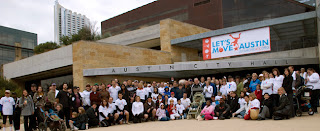Runners, walkers, bikers, dogs and babies (being pushed in jogging strollers, at least) all enjoy the trails at Town Lake. I discovered the trails when I started running, and they became a huge part of my half marathon training – there’s no better scenery than downtown Austin and a beautiful lake to help you reach your runner’s high.
But recent attention to trail dangers has some implications for those who like to work out in the great outdoors. Last fall, a young woman in my Dallas hometown was killed on Katy Trail, a path I have run several times. She was struck in a collision with a cyclist and passed away three days later.
 |
| Lauren Huddleston, age 28. Photo Credit: KDFW News |
The tragedy has led to cautionary guidelines and city debates for rules and regulations for Dallas trails. But what about the trails in Austin? And what else do Austin’s fittest need to be careful about?
The Path to Safety
Eighteen park rangers have been patrolling Austin’s trails since last September thanks to $1.1 million in city funding, according to the Austin American-Statesman article posted yesterday. The City of Austin’s Park Ranger Program encourages a “prudent speed” for bike-riders and describes the right-of-way system among walkers, joggers and cyclists.
“If a cyclist is moving four to five times faster than a runner, that’s a recipe for disaster,” said Jack Murray, co-owner of Jack and Adam’s triathlon shop, in the Statesman article. “Then you add earphones to either of them, any type of uneven terrain or variable, and something like what happened in Dallas could happen here.”
Park rangers can’t issue tickets, but they do stop to “educate trail users about the trail, including reminding them of proper trail etiquette,” the article said. About 2,200 reminders were warranted since September, surely preventing disaster – there is only one report of reckless riding in the same time period.
Tips for Trail-ers
| Me and Mom at the 2010 Too Hot To Handle 15K |
I have learned from my runner mother that there is more to worry about than collisions and trail congestion. Her 10 years of being a runner, combined with my two years, have inspired me to make a safety checklist for all the trail-enthusiasts out there:
- Treat walking, running or biking on a trail as you would driving on a highway: stick to the right side of the path, look both ways before you cross, don’t cut people off and pass people safely. If you’re biking, just call out “on your left.” I thought the verbal warning was rude when I started running, but I quickly learned it’s more frightening for a bike to whiz past you without notice.
- If you use headphones while you exercise, use just one of the earphones or turn down the volume enough to be able to hear street traffic. It’s important to be able to hear what’s going on around you! An added bonus: your ear drums will thank you, as just five minutes of listening to music on headphones full-blast can cause permanent damage.
- Don’t take valuables with you or wear jewelry. Tie your car or house key to your shoe strings, leave your wallet at home, and keep expensive gadgets like listening devices, cell phones and watches to a minimum.
- Have a form of identification on you in case of a medical emergency. My mom got me a RoadID for Christmas, and I honestly feel more prepared when I’m out running alone. A few of my cyclist friends have RoadIDs as well.
- Try to avoid exercising outside at night. If you have to, take a buddy – it can be more fun anyway! Also be careful of uneven terrain; I have a lot of friends who have fallen in the dark because of cracked concrete and rocks they couldn't see.
- As the Texas weather continues to heat up, it is imperative to stay hydrated. Drink at least eight big glasses of water a day and take advantage of water fountains on trails. Work out in the mornings or at dusk to miss the hottest part of the day.
These are the general safety rules I have set for myself. If you have any to add, please comment with suggestions!


